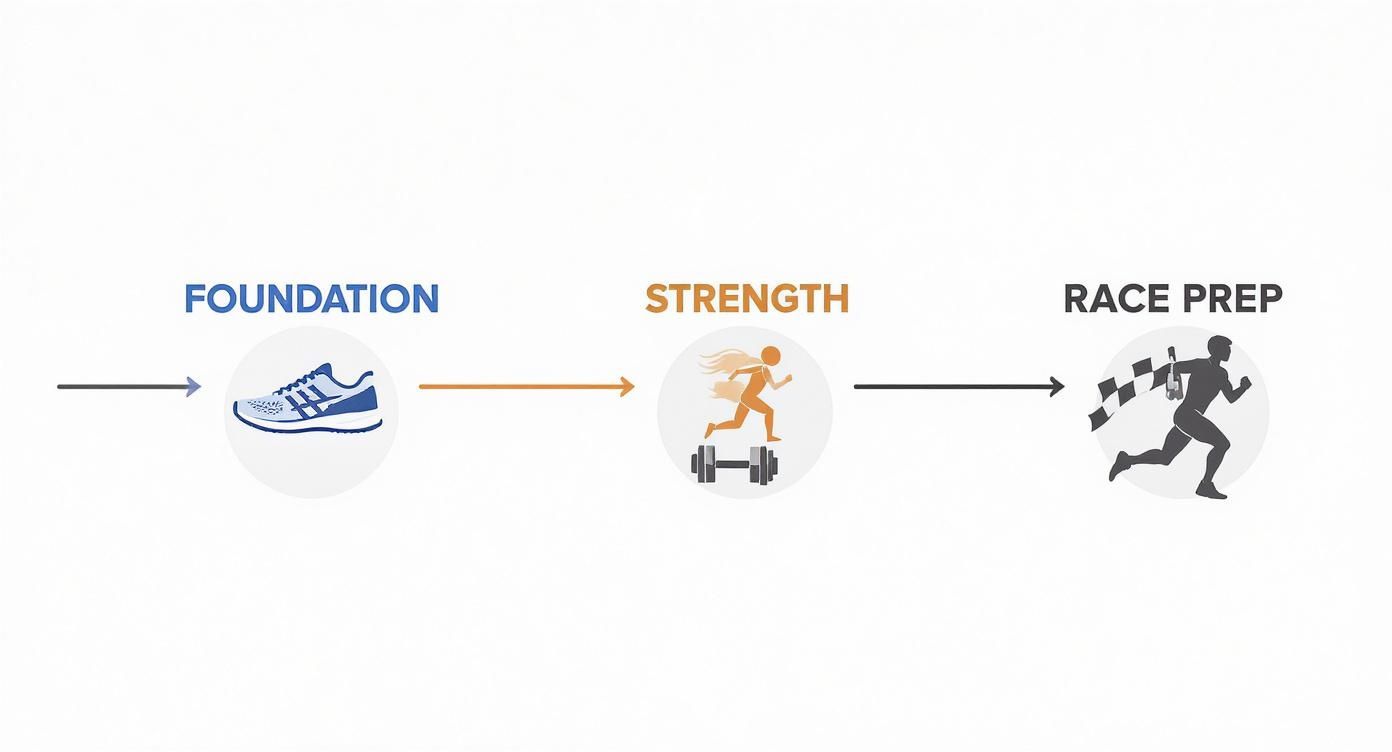Absolutely. Twelve weeks is the sweet spot for getting ready for a 10K. It gives you enough time to build up your stamina and get a little faster without pushing your body too hard, too soon. This guide lays out a complete 10k training plan 12 weeks in the making, perfect for first-timers or anyone looking to set a new personal best.
Your Complete 12 Week 10K Roadmap
Taking on a 10K can feel like a massive undertaking, but when you spread it out over three months, it becomes incredibly doable. Think of this plan less as a strict rulebook and more as your personal guide. The real secret to success is making steady, gradual progress and, most importantly, listening to your body to sidestep burnout or injury.
We've broken the entire journey into three distinct phases to give you a clear view of what’s ahead. This method helps you build a solid running foundation before we start throwing in the tougher stuff, making sure you feel strong and confident when you toe the starting line.
Your weekly schedule will be a mix of a few core ingredients:
- Easy Runs: These are the bread and butter of your training, done at a pace where you could comfortably hold a conversation. They build your aerobic engine.
- Long Runs: Once a week, you'll go a little farther. This is all about building endurance and the mental grit to keep going.
- Speed Work: We'll sprinkle in some faster-paced workouts like intervals later on to help you pick up the pace.
- Rest Days: These are just as important as your runs. Your muscles need time to repair and get stronger. Don't skip them!
The Three Phases of Your Training
This visual gives you a bird's-eye view of the next 12 weeks, breaking the plan down into the Foundation, Strength, and Race Prep phases.

As you can see, each four-week block has a clear purpose, smoothly transitioning you from just getting into a running routine to being fully prepared for race day.
Let's take a closer look at how this all fits together. The table below breaks down each phase, showing you what to focus on and what your key workouts will look like along the way.
The 12 Week 10K Training Plan At a Glance
| Phase | Weeks | Primary Focus | Example Key Workouts |
|---|---|---|---|
| Foundation Building | 1-4 | Building consistency and a solid aerobic base. Getting your body used to running regularly. | 3 x Easy Runs (20-30 mins) 1 x Long Run (start at 3 miles) |
| Strength & Speed | 5-8 | Increasing endurance, introducing faster running, and building mental toughness. | 2 x Easy Runs 1 x Intro to Intervals (e.g., 6x400m) 1 x Long Run (building to 5 miles) |
| Race Preparation | 9-12 | Sharpening your fitness, practicing race pace, and tapering before the event. | 1 x Easy Run 1 x Tempo Run (20 mins at a challenging pace) 1 x Long Run (peak at 6 miles) 1 x Taper Week |
This structure is why a 12-week plan is so often recommended for new runners—it intelligently balances the workload with crucial recovery time. Most beginner plans start you off with about 10-15 kilometers of running per week and follow the golden rule of increasing your total mileage by no more than 10-15% each week. This slow-and-steady approach is your best defense against injury.
This phased approach is your secret weapon for success. By focusing on one goal at a time—first consistency, then strength, then speed—you build momentum and confidence without feeling overwhelmed.
Ultimately, having a plan like this takes the guesswork out of training. You'll wake up knowing exactly what you need to do, which is a huge motivator on those days when you'd rather hit snooze. While this is a fantastic starting point, you can always discover a variety of other running plans for different distances and goals to keep your running journey going.
Weeks 1-4: Building Your Running Foundation
Alright, let's get started. The road to a 10K begins with building a solid foundation, not by sprinting out of the gate. These first four weeks are all about getting your body used to the routine and rhythm of running.
Forget about speed for now. Seriously. One of the biggest mistakes runners make is pushing too hard, too soon, which is a fast track to injury or burnout. Our mission here is to build your aerobic base—the engine that will carry you through this entire 10k training plan 12 weeks from now. Think of it like laying the foundation for a house. The stronger it is, the more you can build on top of it.
What an Easy Run Should Feel Like
You'll see "Easy Run" on the schedule a lot. But what does that actually feel like?
The best way to know if you're in the right zone is the talk test. You should be able to hold a full conversation without gasping for air. If you were with a friend, you could chat comfortably. Running solo? Try singing a bit of your favorite song out loud. If you can only spit out one-word answers, you're going too hard. Pull back. That conversational effort is the sweet spot for building endurance.
Your mantra for these first four weeks is simple: Time on your feet matters more than speed. Consistency is your best friend. Finishing a scheduled run, even if it felt slow, is a huge win.
For many, the thought of running for 20-30 minutes straight is intimidating. That's where the run/walk method is a game-changer. It’s an incredible tool for building stamina without putting too much stress on your body. By alternating running with short walk breaks, you keep your heart rate up while giving your muscles and joints a quick breather.
This is how you build confidence and fitness while keeping injury risk low. If you’re already running consistently, feel free to just run the whole time at an easy pace. But if you’re newer to this, our complete running schedule for beginners has even more tips to get you going.
Your First Four Weeks of Training
Here’s what your first few weeks will look like. Remember, this is a blueprint, not a strict command. Life happens. Feel free to shuffle your rest days around, but try your best not to run on back-to-back days. Your body needs that downtime to recover and get stronger.
Week 1 Schedule
| Day | Workout | Focus |
|---|---|---|
| Monday | Rest | This is non-negotiable. Recovery is when you improve. |
| Tuesday | Run 1: 20 mins | 4 sets of: 4 mins Run / 1 min Walk. Keep the effort easy. |
| Wednesday | Strength/Cross-Train | 20-30 mins of bodyweight work or even a brisk walk. |
| Thursday | Run 2: 20 mins | 4 sets of: 4 mins Run / 1 min Walk. Keep it conversational. |
| Friday | Rest | Let your muscles repair and rebuild. |
| Saturday | Long Run: 2 miles | Go slow and steady. Take walk breaks whenever you need to! |
| Sunday | Rest or Active Recovery | A light walk or some gentle stretching is perfect. |
As you move through the month, we'll gently nudge the duration and distance up. This is called progressive overload, and it’s the secret to getting fitter without getting hurt.
- Week 2: Bump your weekday runs to 25 minutes (e.g., 5 sets of 4 min Run / 1 min Walk) and your long run to 2.5 miles.
- Week 3: Now, take the weekday runs to 30 minutes (e.g., 5 sets of 5 min Run / 1 min Walk) and the long run to 3 miles.
- Week 4: Keep the weekday runs at 30 minutes, but see if you can shorten the walk breaks. Push your long run to 3.5 miles.
Building Strength on Your Off Days
Running isn't the only thing that will get you to the finish line. A strong, resilient body is your best defense against those nagging aches and pains. On your cross-training days, focus on simple bodyweight exercises. No gym required.
Foundational Strength Moves:
- Squats: These build power in your quads, glutes, and hamstrings. Aim for 3 sets of 10-12 reps.
- Planks: A strong core is everything for good running form. Hold for 30-60 seconds, and do that 3 times.
- Glute Bridges: Wake up your glutes—your running powerhouse muscles. Do 3 sets of 15 reps.
- Lunges: Great for balance and single-leg strength, which is exactly what running is. Try for 3 sets of 10 reps on each leg.
Think of these exercises as building the scaffolding that will support your running. By the end of these four weeks, you’ll have a solid routine and a strong foundation ready for the next phase of training.
Weeks 5-8: Adding Speed and Building Strength

Alright, you’ve put in a solid month of work and built a fantastic foundation. Your body is ready for the next challenge. This is the middle phase of our 10k training plan (12 weeks), and it's where things get really interesting. We're about to shift from building consistency to layering in strength and speed.
Don't let the word "speed" scare you. This isn't about gut-busting sprints. We’re going to introduce some structured workouts that teach your body how to run faster, more efficiently. This is the part of the plan where you really start to feel your fitness click into place.
Introducing New Workouts: Tempo and Intervals
During weeks 5 through 8, you'll see two new kinds of workouts pop up on your schedule: tempo runs and interval training. These are your secret weapons for getting faster, and we’ll ease into them carefully.
Tempo Runs: Think of this as a "comfortably hard" pace. It’s a sustained effort where you’re pushing, but you haven't hit your absolute limit. You should be able to eke out a few words, but definitely not hold a full conversation. Tempo runs are brilliant for improving your lactate threshold, which is just a fancy way of saying you can hold a faster pace for longer before your legs start screaming.
Interval Training: This just means running short, fast bursts followed by a recovery period of walking or easy jogging. Intervals are amazing for boosting your running economy and raw speed. They’ll feel tough in the moment, but the built-in recovery makes them manageable—and incredibly effective.
We'll carefully balance these new, harder efforts with your easy runs and a progressively longer long run. The idea is to introduce a new challenge without completely overwhelming your system.
This is where you learn to push your boundaries in a smart, controlled way. Leaning into the discomfort of a tempo run or the challenge of intervals is how you unlock new levels of fitness and mental grit.
Your Mid-Plan Training Schedule
As we dive into this block, your weekly mileage will start to creep up. This gradual increase is key. In fact, most successful 10K training plans follow a 10-15% weekly increase to safely build fitness without getting hurt. This smart progression builds your aerobic engine and muscular endurance, getting you ready for the demands of race day. For a deeper dive into how training volume affects performance, the folks at RunToTheFinish.com offer great insights on how to train for a 10K.
Here’s what a typical week might look like in this phase. Notice we’re swapping out one easy run for a "quality" session each week.
Week 5 Schedule Example
| Day | Workout | Details and Focus |
|---|---|---|
| Monday | Rest | Absolutely non-negotiable. This is when you get stronger. |
| Tuesday | Easy Run: 30 mins | Keep the pace totally conversational. Chill out. |
| Wednesday | Intervals: 30 mins total | Warm-up, then 6 x 400m (one lap of a track) at a hard effort, with a 400m easy jog/walk to recover between each. Cool-down. |
| Thursday | Strength/Cross-Train | 30-40 mins of bodyweight work, or hop on a bike or go for a swim. |
| Friday | Rest | Final day to recharge before your long run. |
| Saturday | Long Run: 4 miles | Focus on a steady, comfortable effort. Run by feel, not by your watch. |
| Sunday | Active Recovery | A light 20-30 minute walk or some gentle stretching does wonders. |
How to Adjust and Listen to Your Body
This is probably the most demanding part of the plan so far, so it’s crucial that you listen to what your body is telling you. Some days you’ll feel like you’re flying; others, you’ll feel like you’re running through mud. That’s normal.
Here’s how to make smart decisions on the fly:
Feeling Great? If you’re feeling extra strong during an interval workout, maybe push the pace a little on the last one or two reps. Just resist the temptation to smash every single one—consistency beats intensity.
Feeling Tired? If you’re feeling completely wiped out, don’t force a hard workout. It’s far better to swap that interval session for an easy run or even take an extra rest day. Pushing through deep fatigue is a fast track to injury. One modified workout won’t ruin your race.
Sore Muscles vs. Real Pain: You need to learn the difference between normal muscle soreness (what we call DOMS) and sharp, specific pain. General soreness is fine; it means you worked hard. Sharp, stabbing, or localized pain is a red flag. If you feel that, stop.
By the end of week 8, you'll have built some serious endurance and unlocked a whole new gear of speed. Your confidence will be sky-high as you head into the final, most exciting part of your training.
Weeks 9-12: Sharpening Up for Race Day

This is it. You're in the home stretch of your 10k training plan, and after 12 weeks of dedication, the real fun begins. You’ve already built a solid foundation of strength and endurance. Now, it's all about fine-tuning your fitness so you can arrive at that starting line feeling strong, rested, and ready to go.
All that consistent effort is about to pay off big time. These last four weeks are split into two crucial parts: one final push to your peak fitness, followed by a smart reduction in training called the taper.
Reaching Your Peak Fitness
Weeks 9 and 10 are the summit of your training. This is where you'll tackle your longest runs and some of your toughest speed workouts of the entire plan. Don't worry, your body can handle it now. These final hard efforts are exactly what you need to simulate the demands of the 10K.
Think of these weeks as your dress rehearsal. Use your long runs to nail down your fueling and hydration strategy. During your tempo runs, really focus on locking into that goal race pace. You’re not just building fitness anymore; you’re practicing for the main event.
The Art of the Taper
Weeks 11 and 12 are all about the taper. It's probably the most misunderstood part of any training cycle, but it's absolutely critical for a good race day. Tapering just means you're intentionally cutting back your mileage to let your body fully recover, repair muscle, and top off its energy stores.
A lot of runners get antsy during the taper. They worry they're losing all the fitness they just worked so hard to build. I promise you, the exact opposite is happening. Tapering doesn't erase your hard work—it lets it shine. You'll still do some high-quality running to stay sharp, but the overall volume will drop way down.
The point of a taper isn’t to gain more fitness; it’s to shed all the accumulated fatigue. Trust the process. You want to feel fresh and springy on race day, not tired from overtraining.
The beauty of a 12-week plan is that it gives you enough time for this structured peak-and-taper cycle, which lines up perfectly with how our bodies adapt. It's become the gold standard for a reason. If you want to hear from other runners, you can find some great impressions on a 10K training plan from the community to see how it worked for them.
Your Final Training Push and Taper
Here’s a look at how to approach your last month. The intensity stays high for a bit, but pay close attention to how the total mileage drops off in those final two weeks. That's your secret weapon.
Week 9 Schedule Example
| Day | Workout | Details and Focus |
|---|---|---|
| Monday | Rest | Absolutely essential for recovering from your weekend. |
| Tuesday | Tempo Run: 40 mins | Warm-up, then hold a comfortably hard pace (RPE 6-7) for 20 mins. Cool down. |
| Wednesday | Easy Run: 30 mins | Keep the pace genuinely easy and conversational. |
| Thursday | Strength/Cross-Train | Think maintenance. Light strength work or 30 mins of low-impact cardio. |
| Friday | Rest | Final day of rest before your peak long run. Get ready! |
| Saturday | Long Run: 5.5 miles | Your last big distance push. Focus on a steady, controlled effort. |
| Sunday | Active Recovery | A light walk or some gentle stretching is perfect. |
Progression for the Final Weeks:
- Week 10: This is your final peak week. Your tempo run might get a little spicier with some faster intervals, and your long run will hit its max distance of 6 miles (or right around 10K). Finishing this run is a massive confidence booster!
- Week 11 (Taper Begins): Time to pull back. We’re cutting your total mileage by about 30%. Your long run will drop to a much more manageable 3-4 miles. You'll still do a light workout, maybe some short strides, just to keep your legs feeling sharp.
- Week 12 (Race Week): Training volume is super low. Plan on two very short, easy runs early in the week, maybe with a few strides at race pace thrown in. Take the two days before the race as complete rest days, or do a very short 10-15 minute shakeout run the day before if that helps you feel loose.
Race Week Final Preparations
The training might be winding down, but you're not done yet. The last few days are all about logistics and getting your head in the game.
- Carb-Load (Don't Carb-Bomb): For 2-3 days before the race, just shift the balance on your plate to include more carbohydrates. Think familiar foods like pasta, rice, and potatoes. You're not trying to stuff yourself, just ensuring your muscles are fully fueled.
- Hydrate Smartly: Sip water consistently in the days leading up to the race. Don't try to chug a gallon on race morning—that's a recipe for sloshing and side stitches.
- Lay Everything Out: The night before, get your entire race kit ready. Lay out your bib, safety pins, shoes, socks, and race-day outfit. This simple step removes so much stress on race morning.
- Trust Your Training: You did it. You put in 12 weeks of consistent work. You are ready for this. Think back on all those tough workouts you pushed through. Let that confidence carry you all the way to the finish line.
Fueling Your Runs and Staying Injury-Free
https://www.youtube.com/embed/UHMqb_pETQU
Putting in the miles is only half the battle. If you want to cross that finish line feeling strong, what you do off the track is just as important as the running itself. Fueling your body correctly and taking smart steps to prevent injuries will make or break your training cycle.
This isn't about some crazy, restrictive diet. It’s about making smart choices to give your body the high-quality fuel it needs to perform, recover, and get stronger.
What to Eat Before and After Your Runs
Nailing your nutrition timing can be the difference between a run that feels effortless and one that feels like a total slog. The goal is simple: top off your energy stores before you start and restock them as soon as you finish.
Pre-Run Fuel
Try to have a light, carb-heavy snack about 60-90 minutes before you head out the door. This gives you just enough time to digest, so you won’t feel sluggish, but the energy will be ready when you need it. Anything too heavy, fatty, or fibrous is a recipe for an upset stomach mid-run.
If you need more inspiration, our complete guide on what to eat before a run is packed with ideas.
A few of my go-to options are:
- A small banana with a bit of peanut butter
- A piece of toast with a thin layer of jam
- A small bowl of instant oatmeal
Post-Run Recovery
You've got a "golden window" of about 30-60 minutes after your run to kickstart the recovery process. This is when your body is incredibly efficient at absorbing nutrients. Your post-run snack should have a mix of carbs (to restock your energy) and protein (to repair your muscles).
Think simple and effective:
- A smoothie with fruit and a scoop of protein powder
- Greek yogurt with a handful of berries
- Good old-fashioned chocolate milk—it works wonders!
And don't forget about hydration! Sipping water throughout the day is far more effective than chugging a bunch right before you run. A glass an hour before you start and plenty afterward is a solid routine.
Preventing Common Running Injuries
Nothing derails a great training plan faster than an unexpected injury. The good news? Most common issues like shin splints, IT band syndrome, or runner's knee are totally preventable. They usually pop up when we do too much, too soon, or skip the little things that keep our bodies happy.
You can't be consistent if you're not healthy. A simple 10-minute warm-up and cool-down is probably the single best investment you can make in your running.
A dynamic warm-up is non-negotiable. Forget those old-school static stretches before a run; your goal is to get the blood flowing and prepare your muscles for action. Just five minutes makes a huge difference.
A Quick and Effective Warm-Up
- Leg Swings: Do 10-12 swings forward-and-back and 10-12 side-to-side on each leg.
- High Knees: For 30 seconds, focus on driving your knees up toward your chest.
- Butt Kicks: Another 30 seconds, bringing your heels up toward your glutes.
- Walking Lunges: Take 10 lunging steps with each leg to wake up your hips and glutes.
Once you’re done, don't just stop cold. A proper cool-down helps ease your body back to its resting state. Walk for the last five minutes of your run, then do some gentle static stretches, holding each for about 30 seconds. This is also the perfect time to grab a foam roller. A few minutes on your quads, hamstrings, and calves can work out tightness and keep you ready for the next run.
Your 10K Training Questions Answered

As you get deeper into this 12-week 10K training plan, you're going to have questions. That's a good thing! It means you're paying attention to your body and the process. Let’s clear up some of the most common things that trip runners up.
What Happens If I Miss a Run?
First, don't panic. Life gets in the way sometimes, and missing a scheduled run is inevitable. The biggest mistake you can make is trying to cram two workouts into one day to "catch up." That’s a surefire way to get hurt.
My rule of thumb is pretty simple: if you miss just one or two runs, let them go. Seriously. Just jump back into the schedule where you’re supposed to be. If you happen to miss a key long run, you can usually push it to the next day and just swap your rest day.
But what if you miss a whole week because of a vacation or a cold? In that case, it's smart to step back and repeat the previous week's training. This lets your body ease back into the routine safely without a sudden jump in mileage.
Am I Running at the Right Effort?
Pacing can feel like a dark art, especially with terms like "easy" and "tempo" thrown around. How do you know if you’re doing it right? You don't need a fancy watch; just learn to listen to your body.
- The Talk Test: This is your best friend on easy days. You should be able to chat with a running buddy in full sentences without gasping for breath. If you can only spit out a word or two, you’re going too hard. Back it off.
- Rate of Perceived Exertion (RPE): Think of a scale from 1 (sitting on the couch) to 10 (an all-out sprint). Your easy, conversational runs should feel like a 4-5/10. That harder, "comfortably hard" tempo effort should land in the 6-7/10 range.
Your body is the most advanced piece of running tech you'll ever own. Tuning into its signals—your breathing, how your legs feel—is far more valuable than staring at a GPS watch.
How Do I Choose the Right Running Shoes?
Your shoes are, without a doubt, the most important gear you’ll buy. Getting the right fit is crucial for preventing injuries and actually enjoying your runs. Please don't just buy what your friend recommends or whatever has the best online reviews.
Your best bet is to go to a specialty running store. The staff there are experts who will watch you run, analyze your gait, and recommend shoes that match your specific foot mechanics. Once you have the right pair, keep an eye on the mileage. You'll want to replace them every 300-500 miles because the cushioning breaks down long before they look worn out.
Are Warm-Ups and Cool-Downs Really Necessary?
Yes. I can't stress this enough. Skipping these is one of the most common rookie mistakes. These brief routines are your first line of defense against injury and make a huge difference in how you recover.
Your 5-Minute Dynamic Warm-Up (Before Every Run):
- Leg Swings: 10 forward/back and 10 side-to-side on each leg.
- High Knees: 30 seconds.
- Butt Kicks: 30 seconds.
- Walking Lunges: 10 per leg.
Your 5-Minute Cool-Down (After Every Run):
- Walk: End every run with 5 minutes of walking to let your heart rate come down.
- Static Stretches: Gently hold stretches for your quads, hamstrings, and calves for 30 seconds each.
Making these non-negotiable parts of your routine will keep you running healthy and feeling strong all the way to the finish line.
At THE RUNNING, we're dedicated to helping you achieve your goals, whether it's your first 5K or a new marathon personal best. Explore our extensive library of training plans, gear reviews, and expert advice to become a stronger, healthier runner today. Find your next challenge at https://www.the-running.com.








